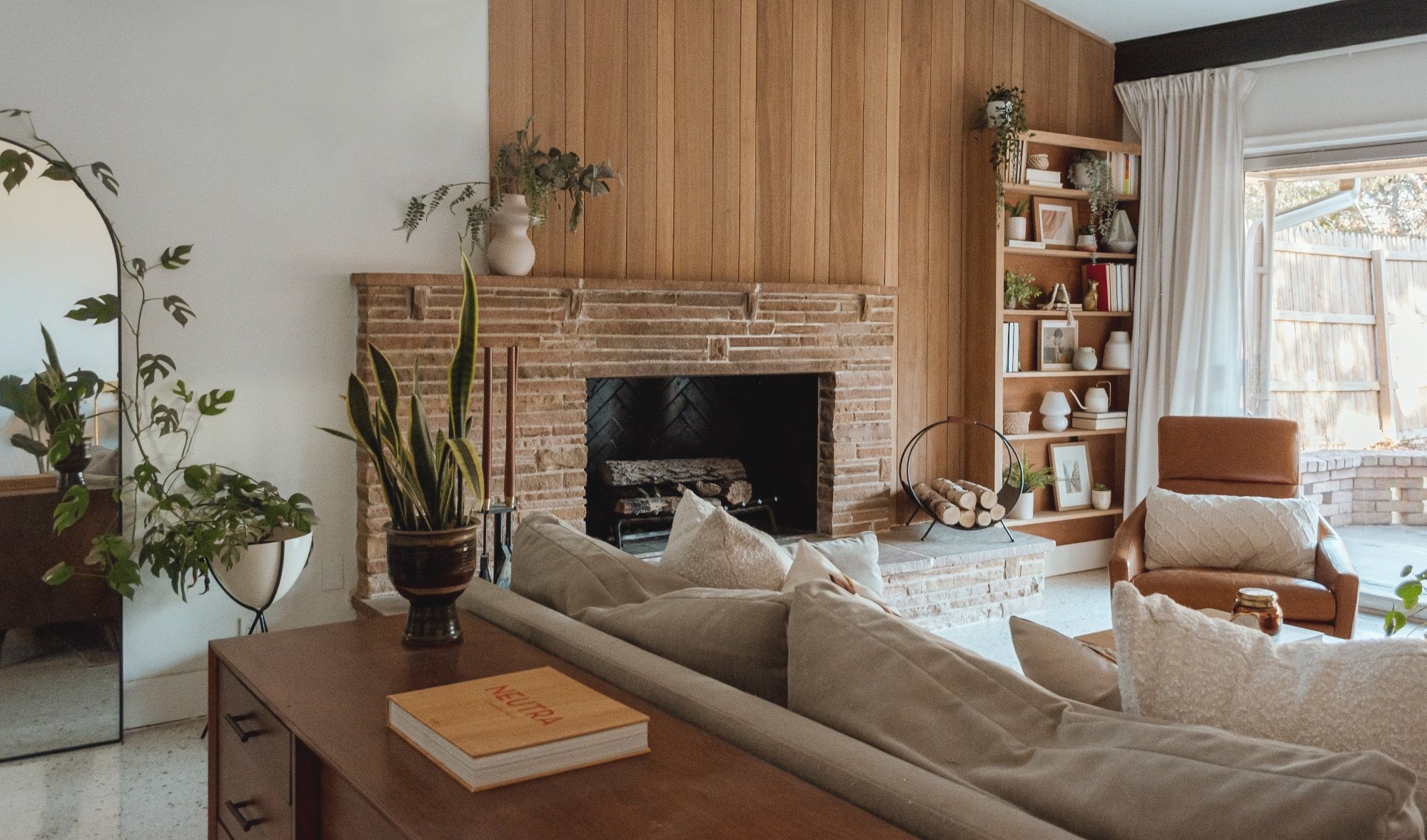How to Mix Wood Tones Like an Interior Designer
One of the most common questions I get asked by clients at design presentations is, “can I mix wood tones?” The answer is always a resounding YES-as long as you follow a few key design rules. In fact, mixing wood tones is one of the easiest ways to create a space that feels layered, curated and full of character.
In this post, I’ll break down exactly how to mix wood tones in your space, just like an interior designer would.
Step by Step Guide on How to Mix Wood Tones:
Step #1: Start with a Dominant Wood Tone
The key to successfully mixing wood tones is to start with one dominant wood tone that anchors the space. In most cases, this will be your flooring or cabinetry if you’re working with an existing space. But that’s not always the case—sometimes, the dominant wood tone comes from a large furniture piece or accent wall, especially in carpeted rooms.
For example, in this own mid-century living room, the terrazzo floors mean the dominant wood tone is the paneling not he fireplace which sets the foundation for the rest of the space. You’ll see this mahogany tone repeated in the credenza behind the sofa and in the handles of the fireplace tools and wood holder.
Your dominant wood tone should ideally make up about 60-70% of the wood in the room, creating a consistent base that other wood tones can complement. Once you have that established, layering in additional wood finishes will feel intentional rather than random.
Step #2: Identify Warm vs. Cool Wood Tones
Now that you’ve established your dominant wood tone, the next step is to identify its undertone so you can choose complementary accent wood tones. Every wood finish leans warm or cool, and understanding these undertones makes mixing wood tones feel intentional instead of clashing.
Here’s a quick breakdown:
• Warm woods: Oak, cherry, walnut – these have golden, red, or orange hues.
• Cool woods: Ash, maple, and certain stained finishes – these have gray, taupe, or espresso undertones.
• Stained woods: Stains can further complicate things, as the final tone depends on both the wood species and the finish applied.
For a cohesive look, stick to either warm or cool wood tones throughout the space. But if you’re looking for something more dynamic, intentionally mixing warm and cool woods creates high contrast and visual energy. This can feel either bold and exciting or jarring—so if you go this route, do it with purpose and balance the contrast with other elements in the room.
Step #3: Vary the Wood Grain for Contrast
Mixing wood tones isn’t just about color—grain pattern plays a huge role in making the combination feel intentional rather than accidental. Just like mixing warm and cool tones creates contrast, so does pairing different wood grains.
A few ways to create contrast with wood grain:
• Pair refined with rustic – A sleek, modern walnut table looks great against a heavily grained oak floor.
• Mix smooth and textured woods – Combining clean, straight-grain woods with knotty, character-filled woods (like pine or reclaimed wood) adds depth and interest.
When working with multiple wood tones, keeping grain patterns varied helps each piece stand out while still feeling cohesive. If everything has the same grain, the space can feel flat and repetitive.
Step #4: Create a Balanced Space with Repetition
One of the easiest ways to make mixed wood tones feel intentional is repetition. If you’re bringing a new wood tone into a space, use it at least twice so it feels like part of the overall design rather than a one-off that sticks out.
For example, if you have a dark wood coffee table, you don’t necessarily need to match it with a dark wood console—but you might bring in the same tone through picture frames, a chair, or cabinet hardware. If you’re using dark floating shelves, try incorporating lighter wood frames or accessories to create contrast while maintaining balance.
The key is to distribute wood tones evenly throughout the space rather than clustering them all in one area. This prevents a “patchwork” look and makes everything feel cohesive and thoughtfully layered.
Step #5: Use Rugs & Textiles to Soften the Transition
When mixing wood tones, rugs and textiles are your best friend. They help break up large wood surfaces and create a natural transition between different finishes.
If you have a dominant wood floor—especially one you don’t love—a large area rug can reduce its visual impact while still allowing some of the wood to peek through. This is especially helpful if you have wood floors that don’t quite match the other wood tones in your space.
Beyond rugs, layering in upholstered furniture, curtains, and soft furnishings keeps a room from feeling too wood-heavy. Even simple elements like a fabric ottoman or upholstered dining chairs can balance out the mix, making the space feel more intentional and cohesive.
Mixing wood tones doesn’t have to feel intimidating—as long as you follow a few key design rules, you can create a space that feels layered, cohesive, and intentional. By starting with a dominant wood tone, understanding undertones, and using contrast and repetition, you can mix wood tones like a designer and bring warmth and depth to your home.
Still unsure about how to get the mix just right? This is exactly what we help our clients with. Book a complimentary project planning call with me, Courtney Batten, and let’s create a space that feels effortlessly curated and uniquely yours.
YOU MIGHT ALSO LIKE…






